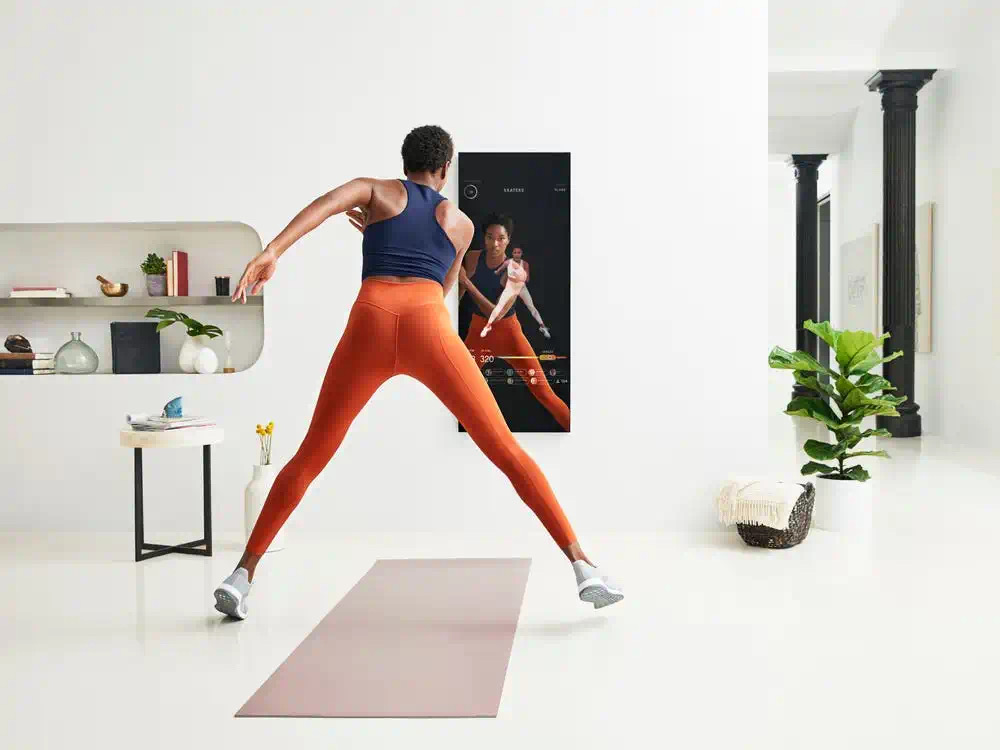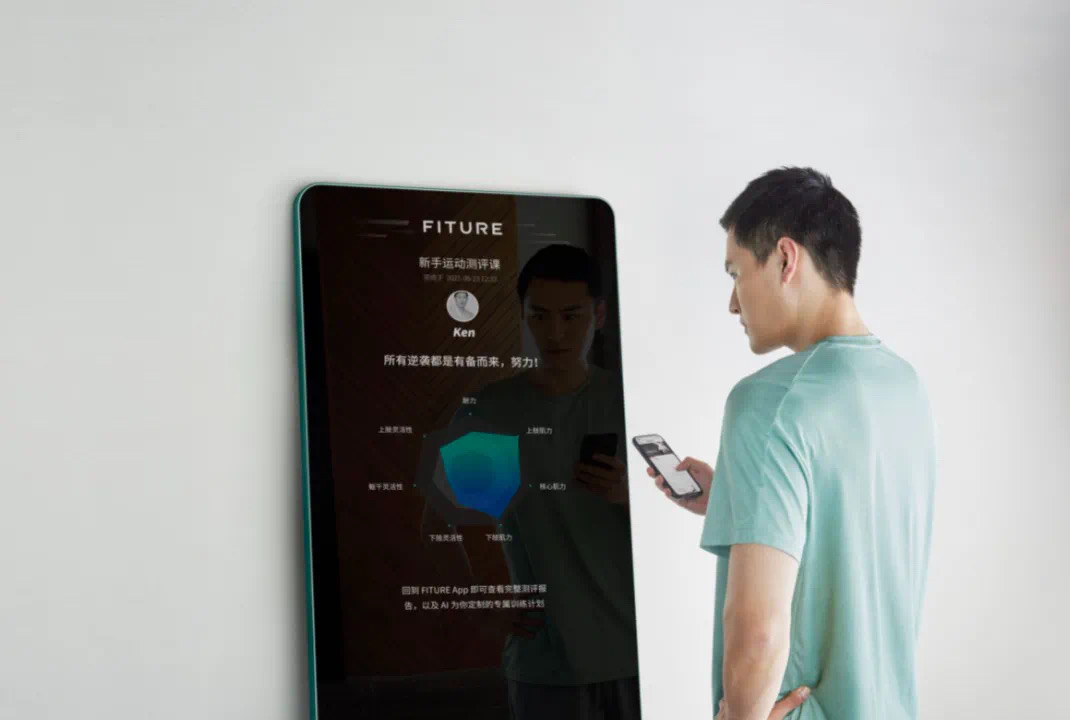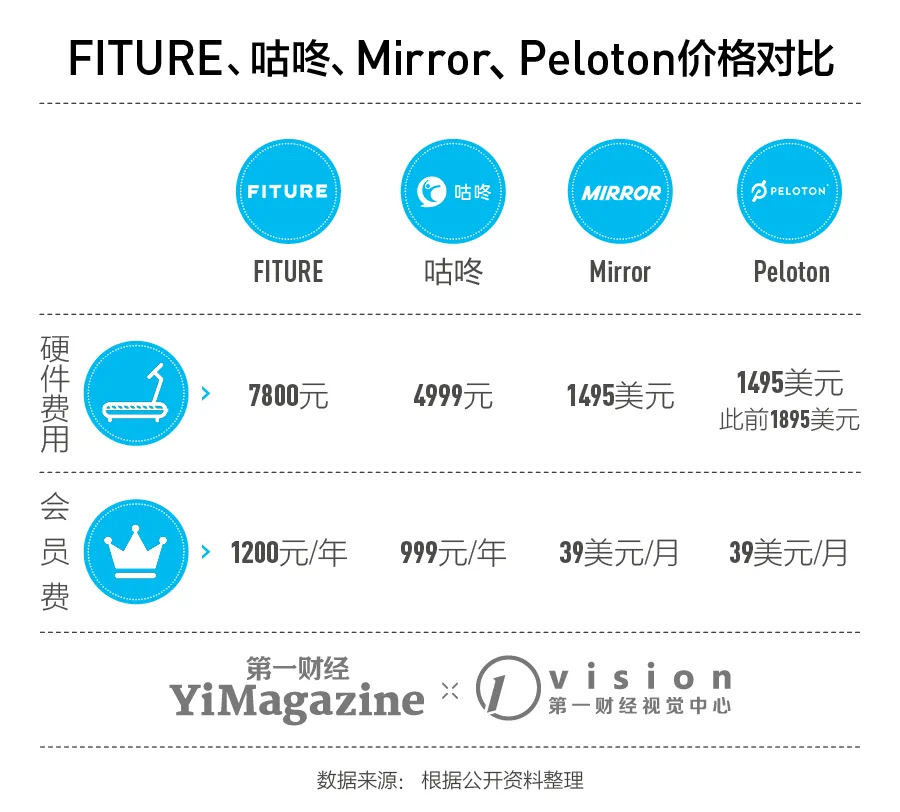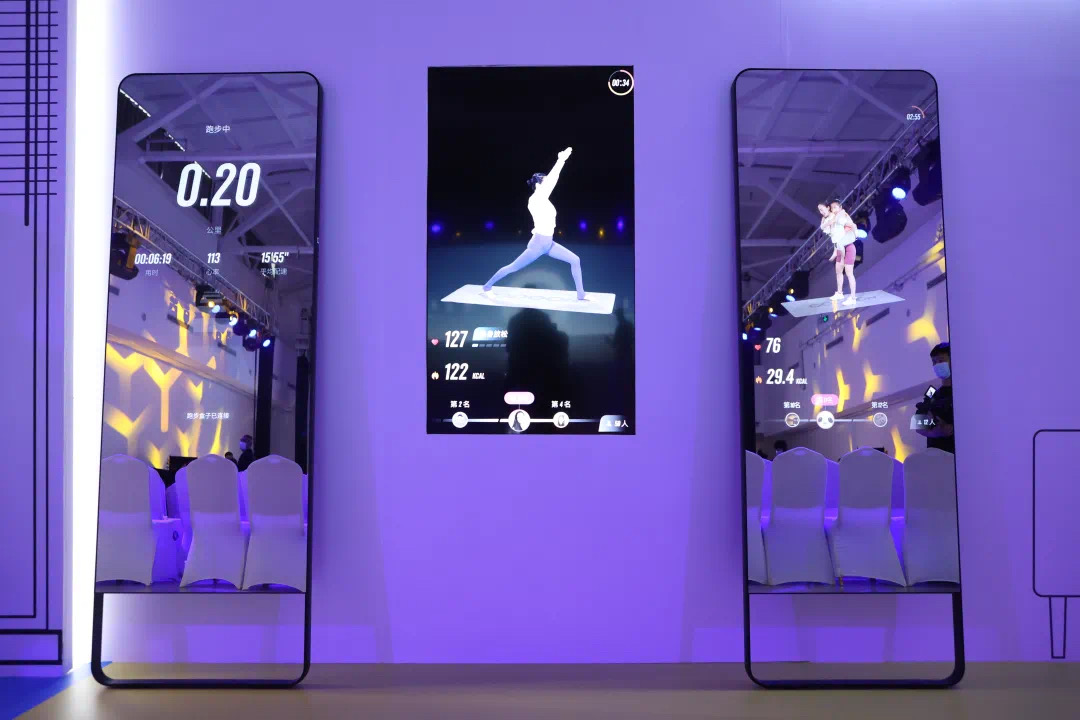
What equipment do fitness enthusiasts need to work out at home? With limitless online classes and available at-home workouts, a yoga mat, towel, a stretch band, and a pair of small dumbbells may be enough. But in the last year, tons of people have spent around $1,500 to purchase a fitness mirror for their at-home workouts. Mirror, a connected fitness company owned by fitness apparel brand Lululemon, has erupted in popularity.
Li Shuai, who lives in San Diego, bought a fitness mirror at the beginning of last year. When Li bought his mirror, S the pandemic had just broken out, the nearest gym had long lines and was only open for a few hours. On top of it all, as a sports blogger with over a million subscribers on social media platforms, "sports" had become Lee's job.
Li Shuai's main purpose for initially purchasing a mirror was to have something to help him meditate and practice yoga. After purchasing a mirror for $1,495, he also wanted “to see if this type of technology product would pose a threat to offline," Li Shuai told Yi Magazine.
Mirror's founder, former professional ballet dancer Brynn Putnam, came up with the concept of the fitness mirror after she felt uncomfortable working out at a gym while pregnant. In addition to functioning as a regular mirror, the mirror can also be seen as a large screen, making it ideal for content. The Mirror was launched in 2018 as the first fitness mirror. Two years later, Mirror was acquired and popularized by Lululemon for $500 million.

Since then, the fitness mirror has quickly debuted as a new category in smart fitness hardware. Users can scan a QR code on the mirror through their cell phones to enter the control interface, and after choosing a workout, a coach will appear on the mirror. Users can complete the workout with the coach and other students through the mirror. Some products have a camera on top of the mirror to correct movements.
The introduction of the Mirror has also inspired domestic companies to follow suit. Among them, startups like myShape and FITURE, as well as Internet fitness platforms like Keep, Gudong, and Leke, and even big companies like Xiaomi and Baidu are also getting ready to launch smart fitness hardware products.
What's different about the fitness mirror?
Two years after its release, the Mirror’s 2D camera now appears to be a bit behind. The 2D camera does not help the user to correct technique, and so the main function of the Mirror is still coaching live classes and remote guidance. Other companies are utilizing 3D cameras, which are becoming the mainstream fitness mirrors.
Feng Wei, the founder of myShape, compared the 3D depth-of-field camera of the fitness mirror to the Face ID of Apple's cell phone, telling Yi Magazine, "The light points hitting out when Face ID scans the face will do 3D modeling of the face and present an accurate depth map, so the security factor is high. The 3D camera of fitness mirror is to hit the light point on top of the whole body, capturing the user's body skeletal points and movement trajectory."
When myShape launched smart fitness products in 2017, the earliest form of the product was a peripheral screen docked to a TV set, which was used to remind users of action completion performance. In 2020, Feng Wei decided to launch his brand of fitness mirrors after customizing Johnson Mirror's algorithms and interactions for China Taiwan's fitness mirror company, Johnson Group. A representative of Johnson Group described, "Our camera can achieve 85% accuracy in fitness movements, with over 1,000 AI fitness movements in the action library."
Therefore, talent in artificial intelligence has also become the focus of competition for fitness mirror brands. Core members of FITURE's technical team have backgrounds in AI-related projects, such as drones technology. In this way, FITURE designed a system that can achieve the capture and recognition of user movements, and then subsequently provide feedback based on algorithmic error correction.
At present, from user feedback, the fitness mirror still has some functionality issues such as inaccurate facial recognitions, correction delay, lack of voice reminders, monitoring range limitations, etc.
Content is the key to enhancing user stickiness, product differentiation, and expanding market share. Managing Director of GSR Ventures Zhu Xiaohu told Yi Magazine, "The essence of fitness is still a content service industry. Each manufacturer needs to tamp down its competitiveness in the course content services. Otherwise, even if it's a 'hundred mirror war', it's just a 'hundred mirror side.'". At the end of 2020, GSR Ventures participated in a joint investment of more than $20 million in FITURE's A+ round.

Peloton, known as the "Netflix of Fitness," has also inspired fitness mirror functions. Users all over the world are addicted to the company's dynamic bikes priced at about $ 2,000. In addition to its smooth appearance, the key to Peloton's enhanced experience lies in the design of the content. Peloton has a wide range of customizable features and detailed metrics, as well as a selection of coaches tapped into helping cyclists on a personal level. At one point during the epidemic, Peloton was valued at over $40 billion.
Layla is a coach contracted by a domestic fitness mirror brand. The first time she was attracted to coaching was when she attended a group workout class. She said, "I completely forgot about the external pressure in that class and was completely immersed in the exercise process under the guidance of the coach. I think [coaching] is a good profession that successfully influences people to fall in love with sports and thus change themselves."
Currently, the courses built into fitness goggles on the market are mainly company-developed and third-party copyrighted content, with the former costing more.
The pre-development stage of course development requires professional teachers and a research team to choreograph courses, course length, and shelf dates. After confirming the course design with the coaches, the formal recording of the course begins.
"In offline classes, I will visually see whether the students' movements are standard and be able to guide and touch them,” said Layla. “Online classes are more demanding for coaches, requiring not only solid professional skills, interpretation, and oral communication skills, but also the ability to grasp the standard of movement demonstration, the pre-determination of movement range, and the emotional ups and downs of the class." This also meant that early recorded classes had a high rejection rate, with FITURE's initial rejection rate reaching more than 50%. Bear in mind that the cost of a re-recording was nearly $7,820.
Designing a set of classes is not only about finding the right trainer. It’s about creating a better user experience that replicates the atmosphere of an offline gym, even including the experience of sound and light. For this reason, FITURE has set up a 4,000 square meter content factory in Shanghai.
"Currently, we expect to achieve a capacity of 5,000 lessons a year," FITURE President Zhang Yuan-Sheng told Yi Magazine. "This is the world's largest base for interactive content creation."
In Zhang Yuan-sheng's opinion, an interactive course requires a combination of four aspects: screen visual effects, movement teaching design, music, and AI with coaches continuously giving positive feedback to the students and creating an emotional connection with users to achieve the effect of immersing the users in it.
Who will buy the fitness mirror?
Regarding interactive fitness, Zhang Yuan-Sheng views potential users of fitness mirrors to be mainly those who want to work out but do not have the capabilities to work out.
As a professional, Li Shuai believes that users who buy fitness mirrors may have had the experience of group exercise classes, but when there is little demand for strength-based training, such as iron lifting, at which point the functionality of the fitness mirror will come to the forefront. Laila's students also agree with this with most of them having some fitness foundation.
A prerequisite for purchasing fitness mirrors is to have enough activity space at home. At the end of August 2021, the Ministry of Housing and Construction announced that the per capita housing floor area of urban residents reached 39.8 square meters in 2019, while Dongwu Securities integrated 2010 census data and other estimates, the current per capita housing floor area in first-tier, second-tier and third- and fourth-tier cities is 26.4, 34.6, and 37 square meters, respectively. This also means that the North, Guangzhou, and Shenzhen may not be the best scenario for fitness mirror consumption.
Another apprehension consumers might have is in the qualification of coaches and trainers. In addition, the State General Administration of Sports mentioned in the 2015 China Fitness Instructor Career Development Report that 48% of fitness instructors who have been in the profession for 1 to 3 years have no professional background. Inexperienced private instructors have tried to sell classes without having gone through the training themselves. This is why many people are afraid to start working out for fear of spending money on professional trainers who lack experience and will fail to help them see results guidance.
Therefore, a family of three in a second-tier city may have a residential area of more than 100 square meters, and in the absence of many gyms and quality fitness instructors throughout the city, they are more likely to buy fitness mirrors to improve their quality of life. "Users in second- and third-tier cities are more active and willing to trust the content and technology of our national brands," Feng Wei said.
At present, the domestic fitness mirror, depending on the model and function, is priced between 2500 yuan and 8000 yuan. In Zhang Yuan-Sheng's opinion, the seemingly expensive fitness mirror is more "cost-effective" than the gym. "An annual gym card is about $940 to $3,130. To hire a personal trainer in Beijing or Shanghai costs about $78 an hour."

Similar to most smart hardware, the AI technology-enabled fitness mirror has a relatively small profit margin on the hardware side. After a user buys a fitness mirror, the company will generally give away a six-month or year-long membership. After the membership expires, users are likely to begin paying for membership. This paid membership is the main source of sustained revenue.
However, as most companies launch their products for less than a year, the membership of users who have purchased fitness goggles has not yet expired, and there is no data related to membership renewal rates to verify the viability of this business model. In addition, limited by sales and user scale, it is difficult for companies that have not previously accumulated user data to iterate on the curriculum with the current market feedback.
At the same time, fitness mirror companies have to face high operating costs: the share of the coach may be equal to the height of the mirror shipped to the user's home. Some companies even improve user stickiness by providing options for health consultants, nutritionists, and other after-sales services, at a high cost.
Family fitness hub?
Gudong, an Internet sports company founded in 2010, also entered the mirror-making business this year through its sub-brand Fitmore, but it's not making mirrors to sell.
Previously, Goudong covered mainly urban outdoor sports users who were mainly runners. The release of its brand fitness mirror in May was the first step for Goudong to enter the home fitness market.
In consideration of entering the fitness mirror track, Goudong Founder Bo Shen discussed, that this category will help Gudong form a closed-loop from a virtual software platform to an entity. "I think the fitness mirror will become the hub of home fitness in the future. Currently, the market is loaded with screens like bicycles and treadmills, and in the home fitness scenario, we hope to make good use of the fitness mirror as a screen to achieve interconnection with other devices," Said Bo Shen to Yi Magazine.
The concept of a home fitness hub is not new. In 2006, Nintendo launched the Wii console. The Wii Sport and Wii Fit series of games had signaled the beginning of the home fitness trend. At that time, the TV was considered to be the home hub, and Nintendo, Microsoft, and Sony have all laid out in the field.
Compared to TVs, fitness mirrors, which are naturally "vertical," may be more suitable for today's users. Many mobile applications are originally vertical. To this end, TCL has also developed a TV that can project the screen up and has also introduced software developer CoachAI, which allows consumers to use the screen as a full body mirror when working out.
Smart fitness track does not require just smart content development Zhang Yuan-Sheng said that the competition in this market involves hardware, AI, content, community, service, and other aspects.
In addition to GSR Ventures, Sequoia China participated in the multi-million dollar angel and A rounds of financing for FITURE, which had missed out on Peloton's investment. Now, in less than a year, this company has received three more financing rounds in a row, with cumulative funding of nearly $400 million.
"The smart fitness track can have hundred billion dollar scale potential and is definitely a platinum track that is severely undervalued." Zhu Xiaohu said. He believes that this year's "6-18", the entire fitness mirror category sales have had a qualitative breakthrough. And with technology giants like Huawei, Xiaomi, and Baidu laying out smart fitness by releasing smart TVs and large-screen products, the value of this track has formed a wide consensus at the industry end.

The first fitness mirror on the market was released only in recent years. To judge its longevity now may be too early. "If you recognize this direction, this team, this model, we can first let the bullets fly a little longer," Zhu Xiaohu said. He predicts that in the future, other manufacturers will increase investments, and the market competition pattern is expected to change within a year, or even usher in larger changes for at-home smart fitness.